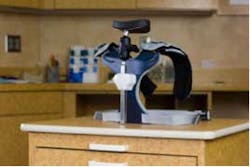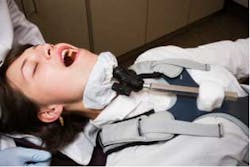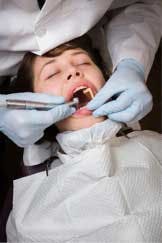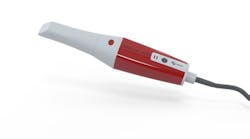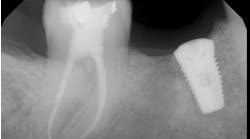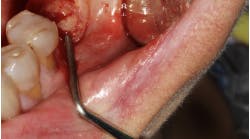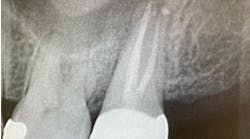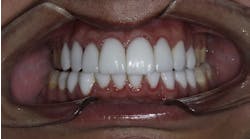The restful jaw: helping take the fear out of dental appointments for TMJ/TMD patients
How an external jaw support device helps treat patients with temporomandibular joint disorder (TMD)
Jaw pain, fatigue, and soreness are a common reality for many patients during and following dental appointments — especially those with temporomandibular disorders (TMD). Throughout my 30 years of treating TMD and orofacial pain patients, a shared concern of increased jaw pain during dental appointments is expressed regularly among this group. In fact, more than 60% of TMD patients seeking care avoided routine dental visits — not to mention elective dental procedures — due to jaw pain. (1)
ADDITIONAL READING |Coding for TMD
If this surprises you, you are not alone. Unless you ask, patients typically do not discuss their jaw pain or preexisting jaw conditions before treatment, and they are reluctant to let it interrupt a dentist during a procedure. Also, they assume nothing can be done to address this problem. And clinicians who are aware of their patient’s jaw pain tell me how time-consuming and difficult it is to treat these patients.
In the past, I typically recommended clinicians minimize treatment-induced pain by providing patients with analgesics and/or muscle relaxants before, during, and after dental procedures, and to use post-treatment self-care including heat or ice. In addition, patients should be given frequent breaks, and clinicians can massage their patient’s jaw. In severe cases, I also suggest the patient schedule physical therapy treatments for the following day. While all of this may be helpful, these remedies can be time-consuming and/or costly for patients and dentists.
In order to comfortably maintain optimum oral health, I recognized the need for a better solution to help our patients alleviate treatment-induced jaw pain and fatigue, especially for those experiencing TMD and orofacial pain. A breakthrough idea came to me when a patient told me one day that she holds her hands under her jaw for support during dental treatments.
After more than a decade of testing and refinement, I created the Restful Jaw®, an external jaw support device. This patented, FDA-registered device is a true win-win situation for patients and dentists alike. It is a simple, comfortable, and noninvasive device that can be quickly fitted and adjusted on any adult-size patient.It supports and stabilizes the jaw so patients no longer have to tense their jaw muscles while open to counter the downward forces from your hand on their jaw.
The majority of patients with or without TMD symptoms find the Restful Jaw device to be comfortable and would use it again. Photo credit: Restful Jaw
When the patient’s jaw is unsupported during dental treatments, several significant issues arise. First, clinicians spend uncompensated downtime managing patients in pain during and after dental procedures. Second, patient jaw pain and fatigue leads to treatment breaks and terminations, contributing to overall treatment delays. Furthermore, dental jaw pain and fatigue can create potential medico-legal consequences for dentists treating both symptomatic and asymptomatic patients. For example, a survey of 164 TMD patients revealed that dental treatments were reported as the most common cause of their TMD pain. (2) In addition, studies report a significant association of common dental procedures causing jaw injury and the onset of TMD. In fact, 23% of young adults attribute the onset of their TMD from third-molar extraction. (3)
The Restful Jaw® device supports the patient’s jaw, provides treatment stability, and is practically unnoticeable during operatory procedures. Photo credit: David Chin www.dchinphoto.com
The Restful Jaw is clinically proven to reduce jaw pain and discomfort during dental treatments (4) and is ideal for use with surgical procedures. Your dental assistant does not need to hold the patient’s jaw during extractions, especially on the mandibular arch. Also, the device enhances precision dental work by stabilizing the jaw and minimizing movement.
“I cannot believe how much he cranked on my jaw but I barely needed to resist,” commented a patient who used the Restful Jaw while having a badly broken-down mandibular molar removed.
When the device is used with a bite block, movement is even better controlled. This is especially important when working on patients with movement disorders such as Parkinson’s disease. The indications are getting more diverse as more patients use it, and they include:
- Any patient having a long procedure, especially on the mandibular arch
- Any procedure where significant force is placed on the jaw
- Symptomatic TMJ/TMD patients
- Asymptomatic patients with signs of TMD
- Problem with overextension of jaw and/or jaw locking open
- Movement disorders (e.g., tardive dyskinesia, Parkinson's, MS, etc.)
- Geriatric patients
- Use as a restraint by putting shoulder straps around the back of the dental chair
A recently published clinical trial (4) assessed the effectiveness of the Restful Jaw and found the majority of TMD patients reported a significant reduction of jaw pain and fatigue when using the device — and found it comfortable to wear and wanted to use it again.
Patients appreciate that you care about their dental experience. A TMD patient commented: "I had residual jaw pain following a cleaning, so I was nervous about getting additional but necessary dental work done, especially since it required substantial pressure on my jaw. When my new dentist used the Restful Jaw device for this procedure, it was reassuring to know they were taking my TMJ seriously. The fact that they had the device meant they were more aware of the issue, and that made me feel more comfortable. In the future, I would screen a dental clinic first to learn what resources they have to support TMJ."
The device is easily cleaned with standard clinical wipes and can be bagged for surgical procedures if needed. Photo credit: David Chin www.dchinphoto.com
During product field tests, clinicians reported saving up to 30% time because of enhanced jaw stability and reduced need for patient treatment breaks. Even on patients without TMD, one study (5) showed the majority of these patients found it comfortable and would wear it if their dentist offered it.
Bottom line: patient jaw pain is a real problem in dentistry and needs to be addressed to help individuals with and without TMD and orofacial pain have a more pleasant dental experience. As such, supporting the patient’s jaw during treatment is crucial to help prevent the onset or exacerbation of patient jaw complaints. In the end, making your patient’s dental experience more comfortable and less painful benefits everyone.
References
1.Humphrey S, Lindroth J, Carlson C. Routine dental care in patients with temporomandibular disorders. J Orofacial Pain. 2002;16:120-134.
2.Fricton et al. Myofascial pain and dysfunction of the head and neck: a review of clinical characteristics of 164 patients. Oral Surg 1985;57:615-627.
3. Huang G, Rue T. Third-molar extraction as a risk factor for temporomandibular disorder. JADA 2000;137(11):1574-1554.
4. Fernandes et al. A randomized Controlled Clinical Trial evaluating the effectiveness of an external mandibular support device during dental care for patients with temporomandibular disorders. General Dentistry. 2013;61(6):26-31.
5. Zucuskie T. A controlled clinical trial of the usefulness of an external mandibular device during routine dental care. 1996. Master thesis. University of Minnesota.

